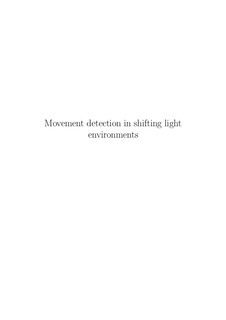| dc.contributor.advisor | Bø, Ketil | nb_NO |
| dc.contributor.author | Nygård, Kristin | nb_NO |
| dc.date.accessioned | 2014-12-19T13:32:59Z | |
| dc.date.available | 2014-12-19T13:32:59Z | |
| dc.date.created | 2010-09-03 | nb_NO |
| dc.date.issued | 2005 | nb_NO |
| dc.identifier | 348065 | nb_NO |
| dc.identifier | ntnudaim:1003 | nb_NO |
| dc.identifier.uri | http://hdl.handle.net/11250/250924 | |
| dc.description.abstract | The task of this assignment is to make an algorithm that can detect movement regardless of how the illumination is. Handling changes in illumination is an important part of creating a stable surveillance system. This problem has been attempted solved here by making a model of the scene which consists of the expectation value and the standard deviation value for each pixel. For every frame that is tested for movement a ratio $p$ is calculated that is the relationship between the actual pixel value $x$, the expectation value $mu$ and the standard deviation value $sigma$. Three different methods were made that use these $p$ values to look for movement. The method that turned out to work best under all conditions compares the $p$ value for each pixel with the $p$ values of its neighbours. This solution is based on the observation that the relation between the greyscale values of pixels in a small area doesn't change. The system is tested both indoor and outdoor. It handles moving shadows and big changes in the illumination without triggering too many false alarms, and at the same time it detects movement under different illumination environments. When tested on a uniform scene it detected 87.7 % of the movement that was presented to the system. The hardest movement to detect were dark objects on a dark background. The system has a problem when the greyscale value of the moving object gets too similar to the greyscale value of the scene. And if the scene has some areas with monotonous texture and some areas with complex texture, the monotonous texture tends to get less sensitive. This problem is proposed solved by splitting the region of interest in several smaller areas, to make each area equally sensitive for movement. | nb_NO |
| dc.language | eng | nb_NO |
| dc.publisher | Institutt for datateknikk og informasjonsvitenskap | nb_NO |
| dc.subject | ntnudaim | no_NO |
| dc.subject | SIF2 datateknikk | no_NO |
| dc.subject | Program- og informasjonssystemer | no_NO |
| dc.title | Movement detection in shifting light environments | nb_NO |
| dc.type | Master thesis | nb_NO |
| dc.source.pagenumber | 76 | nb_NO |
| dc.contributor.department | Norges teknisk-naturvitenskapelige universitet, Fakultet for informasjonsteknologi, matematikk og elektroteknikk, Institutt for datateknikk og informasjonsvitenskap | nb_NO |
